The large arrowhead shaped leaves of Taro plants (Colocasia esculenta) are a familiar sight by the paddy fields or near stream beds and marshy lands in Coorg.
The plants love moisture, and in the powerful winds and relentless rains of the monsoon, they thrive defiantly. If you have the opportunity, stand by a clump of Taro when it’s raining. You’ll be treated to a beautiful sound and water display, as the rain hammers down on and slides off the slopes of the giant leaves. Not quite as dramatic, perhaps, as a dive bomber attack on a battleship, but it does get pretty loud!
Possibly native to the Indo-Malayan region, Taro has made its way around the world. In Hawaiian culture, where the plants played an significant role in the early years of the Polynesian settlement of the islands, it is considered sacred.
Known as Kaymbu in the Kodava language, it is one of the most useful food plants, with its edible corms (kaymbu kandé) stems and leaves.There are several types of Kaymbu that are commonly eaten. The two main ones are the green stemmed and red stemmed (chonde kaymbu) varieties. There is another thicker leafed variety, known as mara (tree) kaymbu, that grows on the sheltered branches of large trees.
Kaymbu in all its forms – corms, stems and leaves, needs to be cooked thoroughly to help neutralize the calcium oxalate crystals (known as raphides ) present in it. The needle like crystals can cause severe irritation to the soft tissues of the mouth and throat. In Southern India, colocasia is almost always cooked using some tamarind in the recipe. While this might seem counter intuitive, to add something sour to the already tart leaves and stems, it may have an effect in further neutralizing some of the calcium oxalate.
Kaymbu leaves may be dried for later use, but usually the tender leaves are picked fresh since they are readily available year round. The leaves of the red stemmed kaymbu are not eaten. It is the deep red stem that is made into a delicious sour sweet curry. Green kaymbu leaves and stems are also curried and the tender leaves made into a tangy chutney. Mara kaymbu leaves are favoured for a version of patrode popular in Mangalorean and Konkani cuisine. It is made by layering the leaves with a paste of rice flour, spices, ground lentils, and tamarind. This is then rolled up and steamed. It can then be sliced and fried after steaming. Mara kaymbu leaves are also chopped into a rice batter and steamed like kulae puttu. The steamed cakes are then cut into pieces and added to sambar. And of course the starchy corms, or kaymbu kandé, were used wherever the potato has now taken over.
In Vancouver, I can find fresh Taro leaves (imported from Fiji ) and even Indian taro roots ( known as arbi or arvi in Hindi and Punjabi, it is popular with the local Indo-Canadian clientele) . I haven’t found red stemmed taro yet, but it’s probably out there somewhere, most likely in a Japanese supermarket. This Japanese pickle recipe tells me I’m looking for Aka-zuiki. Taro by yet another name!
When Vancouver’s Farmers’ market stalls are loaded with beautiful red rhubarb stalks, I make my version of red kaymbu curry, replacing the tart stems of kaymbu, with the equally sour ones of rhubarb. Curiously, when cooked this way, the flavour of the rhubarb reminds me of kaad maangé.
Next time round, I think I’ll add some ripe mangoes!
Chonde kaymbu curry
Red stem taro in a sweet and sour sauce
- 1/2 kg red kaymbu stems, peeled and sliced into 2” lengths or 1/2 kg rhubarb stems
- 1 1/2 tsp ground coriander
- 1 tsp chilli powder
- ½ tsp turmeric
- 2 medium onions, finely sliced
- 3-4 dry red chillis, broken and deseeded
- 5-6 cloves of garlic, crushed
- ½ cup grated coconut, ground to a fine paste (optional)
- I tbsp thick tamarind extract**
- 3 tbsp jaggery
- Salt to taste
- 2-3 tbsp oil
Tempering (optional)
- ½ tsp mustard seeds
- 7-8 curry leaves
- 1 tbsp oil
Heat the oil in a shallow pan and add the mustard and curry leaves if using, followed by the red chillis and garlic. Sauté for two minutes, then add the sliced onions and cook on medium heat until the onions are softened and just beginning to brown. Add the chopped kembu, two cups of hot water and cook on medium-high for two minutes.
Reduce the heat, then add the ground coriander,chilli powder, turmeric and salt. Cook on low heat for five minutes or until the kaymbu is tender. Add the ground coconut and jaggery.Simmer for about two minutes, then put in the tamarind extract and cook for a couple more minutes. Remove from heat and serve immediately.
Do not reheat.
A note if you are using Rhubarb. It cooks and breaks down much faster than kaymbu stems, so adjust your cooking time accordingly. Also, reduce the quantity of water to 1 1/2 cups.
* Versions of this can found in other cuisines like alu wadi in Maharashtra or patra in Gujarat.
** In recipes that don’t use tamarind, the dish is finished with a squeeze of lime or chorangé (a kind of citron) juice. Do not reheat the dish.

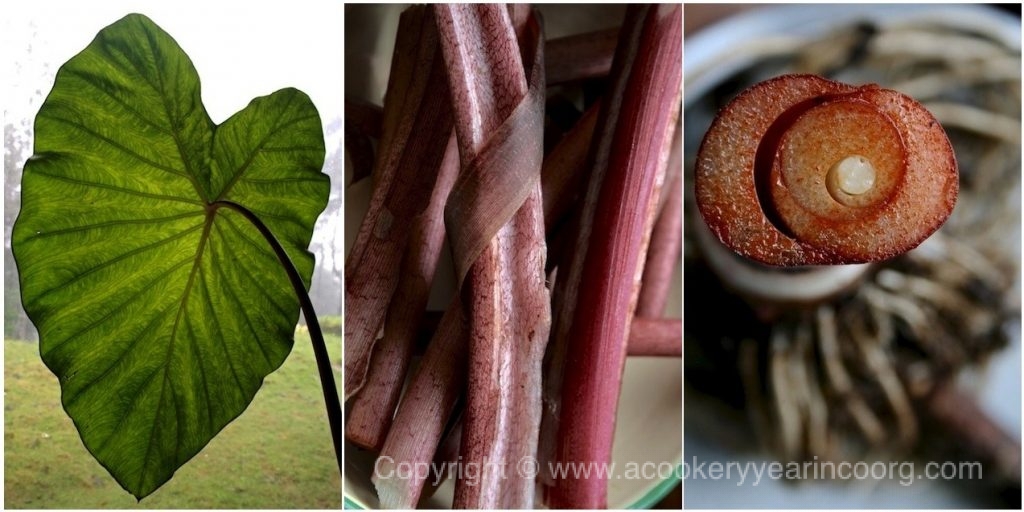
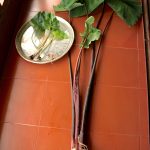
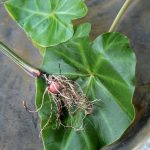
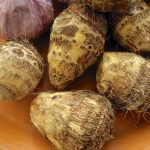
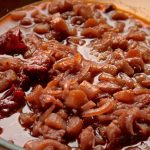
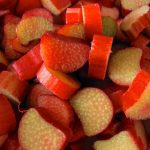
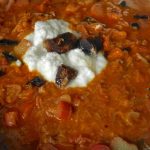
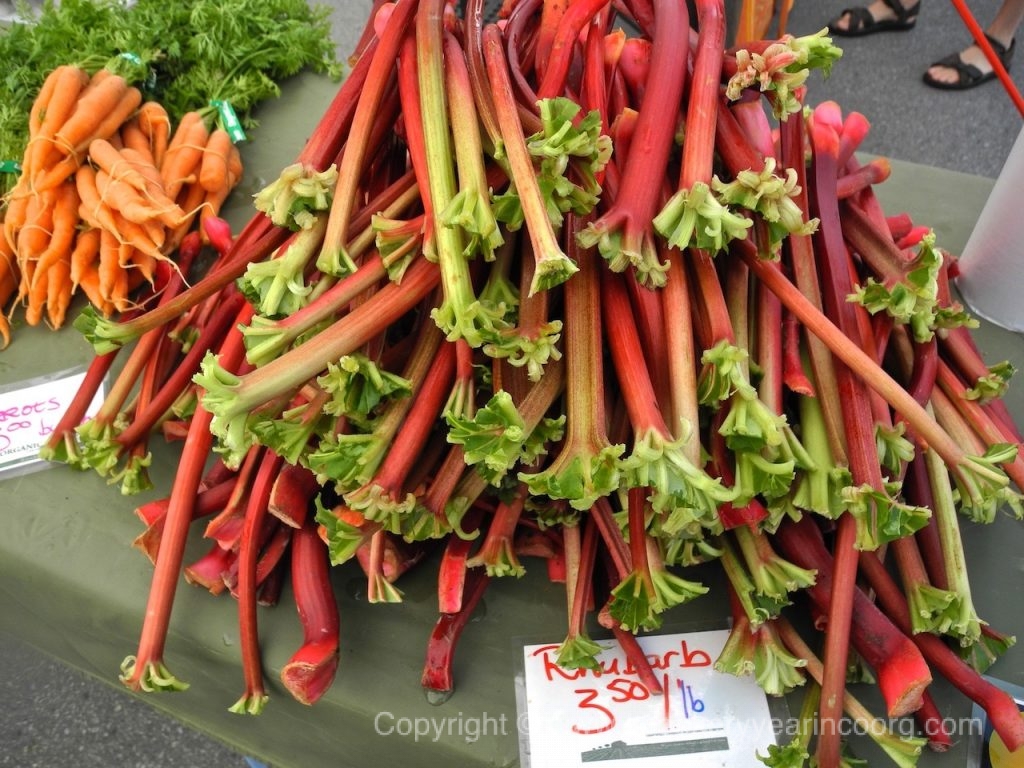
I stumbled on your blog quite accidentally. I’ve enjoyed reading through your posts. You’ve recreated in them, parts of my childhood that I cherish to this day. Summer vacations at my grand parents home was something else. The laughter, endless stream of delicious Kodava dishes shared with family. Every now and then , I have a craving for one of the traditional curries. Not all are in the ” The Essential Kodava Cook Book ” by C.B Muthamma & Gangamma Bopanna. So I try to recreate from memory or from hasty phone calls to my mother. Now I feel I have another resource at hand. “Googling” a variety of spellings for Keymbu brought me here – and I was thrilled to find your version of Keymbu with Rhubarb. Waiting to try this out once I find some fresh Rhubarb in the grocery store. Will get back to you once I try it. In the mean time, keep churning out those posts! I love the attention to detail you display in each post – in both English and Kodava Thakk. Beautifully written, Shalini.
Welcome, Krupa 🙂
Thank you, I’m so pleased you’re enjoying the blog ! I hope you’ll find some of your old favourites and happy variations here. As you might know we do tend to like things on the sharp end of the tart spectrum in Kodava cuisine, and rhubarb seemed just perfect as a stand in for Kaymbu- visually too! The curry is pretty delicious in its own way, and I’m going to try it with added ripe mango the next time I make it. I’m not sure where in the US you are, but if you have a Japanese market handy, you might find red taro stem there.
Thanks again, and I look forward to your feedback and comments!